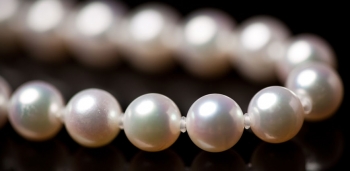Akoya Pearls : Origins and Popular Uses

The most popular type is the akoya pearl, which is used to create akoya pearl strand necklaces, bracelets, rings, earring, and brooches. These precious gems are produced by the Japanese Akoya Oyster. In the wild, oysters will produce pearls if a small irritant finds its way into the oyster and attaches to the right spot inside the oyster’s shell. This is a very rare occurrence; they are cultured on Japanese oyster farms.
Cultured akoya pearls come in a range of hues from pure white to shimmery silver and can have overtones of pink or cream. Factors such as the temperature of the water, the depth at which it is grown, and minerals present in the water determine the specific color of the pearl. These factors can also affect its size and luminosity. At cold temperatures, these are slowly produce thin layers of nacre, the substance that gives a pearl its iridescent, shimmery appearance. This results in very small pearls, as tiny as 2mm in diameter. However, the thin layers of nacre give them a beautiful, luminescent glow. Conversely, they are cultured at warmer temperatures have very thick layers of nacre. They are much larger, up to about 11mm in diameter, but have a very dull appearance. Experienced farmers typically grow them in warmer water at first and then finish the process in colder water. This technique results in cultured akoya pearls that are large but still retain their iridescence.
Once they are ready to be harvested, they are carefully extracted from the oyster. Then, they are sorted by color, size, and shape. Ideally, pearl jewelry is crafted with pearls that all look identical, so some pearl producers resort to using harsh chemicals to dye them and a sanding process to create a standard size and shape. However, these techniques damage the structural integrity of the pearls. Consequently, long akoya pearl strand necklaces made with untreated pearls are some of the most expensive pieces of jewelry available.
Akoya jewelry is elegant, versatile, and timeless. It will surely be sought after for its natural, simple beauty for generations to come, just as it has been for generations past.
